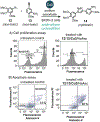Tools and Methods for Investigating Synthetic Metal-Catalyzed Reactions in Living Cells
- PMID: 34824879
- PMCID: PMC8612649
- DOI: 10.1021/acscatal.1c00438
Tools and Methods for Investigating Synthetic Metal-Catalyzed Reactions in Living Cells
Abstract
Although abiotic catalysts are capable of promoting numerous new-to-nature reactions, only a small subset has so far been successfully integrated into living systems. Research in intracellular catalysis requires an interdisciplinary approach that takes advantage of both chemical and biological tools as well as state-of-the-art instrumentations. In this perspective, we will focus on the techniques that have made studying metal-catalyzed reactions in cells possible using representative examples from the literature. Although the lack of quantitative data in vitro and in vivo has somewhat limited progress in the catalyst development process, recent advances in characterization methods should help overcome some of these deficiencies. Given its tremendous potential, we believe that intracellular catalysis will play a more prominent role in the development of future biotechnologies and therapeutics.
Keywords: bioassays; biocompatible; bioorthogonal; flow cytometry; intracellular; mass spectrometry; microscopy.
Conflict of interest statement
The authors declare no competing financial interest.
Figures
























Similar articles
-
Beyond the Second Coordination Sphere: Engineering Dirhodium Artificial Metalloenzymes To Enable Protein Control of Transition Metal Catalysis.Acc Chem Res. 2019 Mar 19;52(3):576-584. doi: 10.1021/acs.accounts.8b00625. Epub 2019 Mar 4. Acc Chem Res. 2019. PMID: 30830755
-
From mechanism to mouse: a tale of two bioorthogonal reactions.Acc Chem Res. 2011 Sep 20;44(9):666-76. doi: 10.1021/ar200148z. Epub 2011 Aug 15. Acc Chem Res. 2011. PMID: 21838330 Free PMC article.
-
Intracellular Catalysis with Selected Metal Complexes and Metallic Nanoparticles: Advances toward the Development of Catalytic Metallodrugs.Chem Rev. 2019 Jan 23;119(2):829-869. doi: 10.1021/acs.chemrev.8b00493. Epub 2019 Jan 8. Chem Rev. 2019. PMID: 30618246 Review.
-
Design and Engineering of Metal Catalysts for Bio-orthogonal Catalysis in Living Systems.ACS Appl Bio Mater. 2020 Aug 17;3(8):4717-4746. doi: 10.1021/acsabm.0c00581. Epub 2020 Jul 27. ACS Appl Bio Mater. 2020. PMID: 35021720
-
In vivo organic synthesis by metal catalysts.Bioorg Med Chem. 2021 Sep 15;46:116353. doi: 10.1016/j.bmc.2021.116353. Epub 2021 Aug 8. Bioorg Med Chem. 2021. PMID: 34419820 Review.
Cited by
-
Metals in Cancer Research: Beyond Platinum Metallodrugs.ACS Cent Sci. 2024 Feb 7;10(2):242-250. doi: 10.1021/acscentsci.3c01340. eCollection 2024 Feb 28. ACS Cent Sci. 2024. PMID: 38435529 Free PMC article. Review.
-
Polarization of macrophages to an anti-cancer phenotype through in situ uncaging of a TLR 7/8 agonist using bioorthogonal nanozymes.Chem Sci. 2024 Jan 9;15(7):2486-2494. doi: 10.1039/d3sc06431j. eCollection 2024 Feb 14. Chem Sci. 2024. PMID: 38362405 Free PMC article.
-
Bioorthogonal nanozymes for breast cancer imaging and therapy.J Control Release. 2023 May;357:31-39. doi: 10.1016/j.jconrel.2023.03.032. Epub 2023 Mar 28. J Control Release. 2023. PMID: 36948419 Free PMC article.
-
Chemical Reactions in Living Systems.Adv Sci (Weinh). 2024 Feb;11(8):e2303396. doi: 10.1002/advs.202303396. Epub 2023 Sep 7. Adv Sci (Weinh). 2024. PMID: 37679060 Free PMC article. Review.
-
A Transfer Hydrogenation Approach to Activity-Based Sensing of Formate in Living Cells.J Am Chem Soc. 2024 Apr 3;146(13):8865-8876. doi: 10.1021/jacs.3c09735. Epub 2024 Mar 12. J Am Chem Soc. 2024. PMID: 38470125 Free PMC article.
References
-
- Oparin AI The Origin of Life and the Origin of Enzymes. Adv. Enzymol. Relat. Areas Mol. Biol 1965, 347–380. - PubMed
-
- Schopf JW; Kudryavtsev AB; Czaja AD; Tripathi AB Evidence of Archean Life: Stromatolites and Microfossils. Precambrian Res. 2007, 158, 141–155.
-
- Robertson AJB The Early History of Catalysis. Platin. Met. Rev 1975, 19, 64–69.
-
- Hartwig JF Organotransition Metal Chemistry; University Science Books: Mill Valley, California, 2010.
Grants and funding
LinkOut - more resources
Full Text Sources
